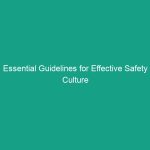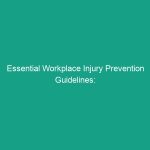Good Morning Team!
Today, we’re going to discuss an important topic that affects our health and Safety at work: Essential VOC – Volatile Organic Compound Guidelines to Ensure Safety. Understanding VOCs is crucial for ensuring a safe working Environment and protecting our health. Let’s dive in!
Understanding Essential VOC – Volatile Organic Compound Guidelines
Volatile Organic Compounds (VOCs) are organic chemicals that have a high vapor pressure at room temperature. This means they can easily evaporate into the air we breathe. VOCs are commonly found in many products we use daily, including paints, solvents, cleaning supplies, and adhesives. When these compounds are released into the air, they can lead to health risks, including headaches, dizziness, respiratory issues, and long-term Effects like liver or kidney damage.
It’s essential to understand that VOCs can significantly impact our daily operations. They can contribute to poor indoor air quality and create unsafe working conditions. Many employees might think that these risks are minimal or that they won’t be affected, but it’s vital to recognize that even low levels of VOCs can be harmful over time.
Key Hazards, Risks, and Safety Considerations
When working with products that emit VOCs, we must be aware of specific Hazards and risks. Here are some key points:
- Inhalation Risks: Breathing in VOCs can lead to immediate or long-term health issues.
- Flammability: Many VOCs are flammable and can pose a fire hazard if not handled correctly.
- Environmental Impact: VOCs can contribute to air pollution and climate change.
- Skin and Eye Irritation: Direct contact with VOC-containing products can cause irritation and allergic reactions.
Ignoring safety protocols related to VOCs can lead to serious consequences, including accidents, health complications, and regulatory fines. It’s critical that we all take these risks seriously and follow Safety Guidelines to protect ourselves and our coworkers.
Best Practices, Procedures, & Actionable Advice
Here are some Best Practices and Procedures to follow when working with VOCs:
1. Proper Ventilation
Always ensure that the area is well-ventilated when using products that emit VOCs. Open windows, use exhaust fans, and consider using air purifiers to reduce concentration levels.
2. Personal Protective Equipment (PPE)
Wear appropriate PPE, such as gloves, goggles, and respiratory protection, to minimize exposure. Always check that your equipment is in good condition and suitable for the task.
3. Safe Storage
Store VOC-containing products in a cool, dry place away from direct sunlight and heat sources. Ensure containers are tightly sealed and labeled correctly.
4. Training and Awareness
Participate in regular safety Training sessions to stay informed about the latest safety practices related to VOCs. Discuss any challenges or experiences you have had with VOCs with your team. This can help raise awareness and improve Safety Measures.
5. Emergency Procedures
Familiarize yourself with emergency procedures in case of a spill or exposure. Know where the safety showers, eye wash stations, and first-aid kits are located.
Case Study: The Importance of Safety
In a recent incident at a nearby facility, a worker was exposed to high levels of VOCs due to inadequate ventilation and failure to wear appropriate PPE. This incident resulted in respiratory issues and required medical attention. It serves as a crucial reminder that we must prioritize safety at all times.
Regulations, Standards, and Compliance
Compliance with safety Regulations is not just about avoiding fines; it’s about protecting our health and ensuring a safe workplace. Here are some relevant Standards:
- OSHA Regulations: The Occupational Safety and Health Administration (osha) sets limits on VOC exposure and requires employers to provide a safe working environment.
- ISO Standards: International Organization for Standardization (ISO) provides guidelines for managing air quality and reducing VOC emissions.
- Company Policies: Our organization has specific protocols regarding the handling and disposal of VOCs. Familiarize yourself with these policies to ensure compliance.
Adhering to these regulations is critical for minimizing risks and ensuring that we all work in a safe environment.
Employee Engagement & Discussion
Now, let’s have a discussion. What safety challenges have you encountered related to VOCs? Are there any specific products you work with that you’re concerned about? Your insights can help us improve our safety practices and address any potential issues.
Conclusion & Key Takeaways
In conclusion, understanding Essential VOC – Volatile Organic Compound Guidelines to Ensure Safety is vital for maintaining a healthy workplace. Remember the following key points:
- Always ensure proper ventilation when using VOC-containing products.
- Wear appropriate PPE to protect against exposure.
- Store and label products correctly to avoid accidents.
- Stay informed about safety regulations and company policies.
Let’s commit to making safety a top priority. Thank you all for your attention and your dedication to maintaining a safe work environment. Together, we can ensure that everyone goes home healthy and safe!


